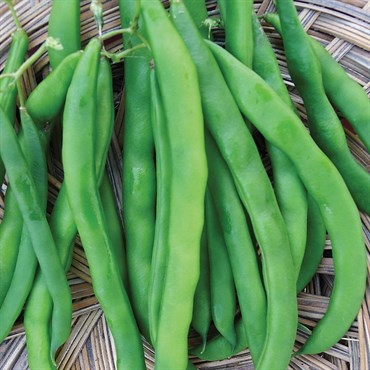Bean Seeds, White Half Runner
Couldn't load pickup availability
Beans, (Bush) White Half Runner Phaseolus vulgaris
HEIRLOOM, Half-runner beans are snap beans that combine the growing habits of a bush bean with those of a pole bean that can be grown with or without support in hardiness zones 3 through 9. Bush White Half Runner Bean, produces round, medium-light green pods. The Pods are almost round and are Stringless when young. They are White seeded with a sweet Flavor. Often used as snap beans, The White Half Runner Beans bear delicious 4-4-1/2" pods from medium-green climbing vines in 52 days. Also excellent canned or frozen.
How to Grow Pole Beans Pole Bean Varieties Bush Bean Varieties How to Grow Bush Beans Companion Plant Guide
- Botanical Name: Phaseolus vulgaris
- Treated: No
- Stringless: Yes
- Bean Type: Bush Snap
- Pod Color: Straight, almost Round, Smooth, light green
- Seed Color: White
- Germination Time: 6-10 Days
- Days to Maturity: 58-85 Days
- Maximum Height: 6-8 Feet
- Spread: vining
- Fruit / Blossom Size: 4-1/2 in Pods
- Breed: Open Pollinated
- Germination Rate: 90%
- Lifecycle: Annual
- Watering: Average
- Sow Method: Direct Sow or Transplant
- Sow Depth: .5 1 inch
- Plant Spacing: 2 inch
- Row Spacing: 30-36 inches
Common Problems
The bean mosaic diseases cause plants to turn a yellowish green and produce few or no pods. The leaves on infected plants are a mottled yellow and are usually irregularly shaped. The only satisfactory control for these diseases is to use mosaic-resistant bean varieties.
Bright yellow or brown spots on the leaves or water-soaked spots on the pods are signs of bacterial bean blight. Bacterial blight is best controlled by planting disease-free seed; avoiding contact with wet bean plants; and removing all bean debris from the garden.
CLASSIFICATIONS: OPEN POLLINATED, HEIRLOOM
Open pollinated means this plants flowers are fertilized by bees, moths, birds, bats, and even the wind or rain. The seed that forms produces the same plant the following year.
All heirlooms are open pollinated, but not all open pollinated plants are heirlooms. Only a small fraction of the plant world is considered heirloom.
- Beet
- Cabbage Family
- Carrot
- Celery
- Chard
- Corn
- Cucumber
- Eggplant
- Pea
Allies:
- Marigold deters Mexican bean beetles
- Nasturtium and rosemary deter bean beetles
- Summer savory deters bean beetles, improves growth and flavor
Enemies:
- Garlic, onion and shallot stunt the growth of beans
Snap beans, string beans, and pole beans are the immature pod and beans of dried legumes. All of these will mature to produce fat seeds and tough inedible pods. The nutritional profile of mature dried beans is very different from that of green beans. Green beans are a good source of carbohydrates. They are a moderate source of protein, dietary fiber, Vitamin C and beta carotene. The beta carotene is converted to vitamin A in the body. Green beans also contain small amounts of calcium and other trace nutrients.
Nutrition Facts (1/2 cup fresh cooked fresh green beans)
Calories 15
Dietary fiber 1.6 grams
Protein 1 gram
Carbohydrates 3.5 mg
Vitamin A 340 IU
Vitamin C 7.5 mg
Folic Acid 21 mg
Calcium 31.5 mg
Iron .4 mg
Potassium 94.5 mg


